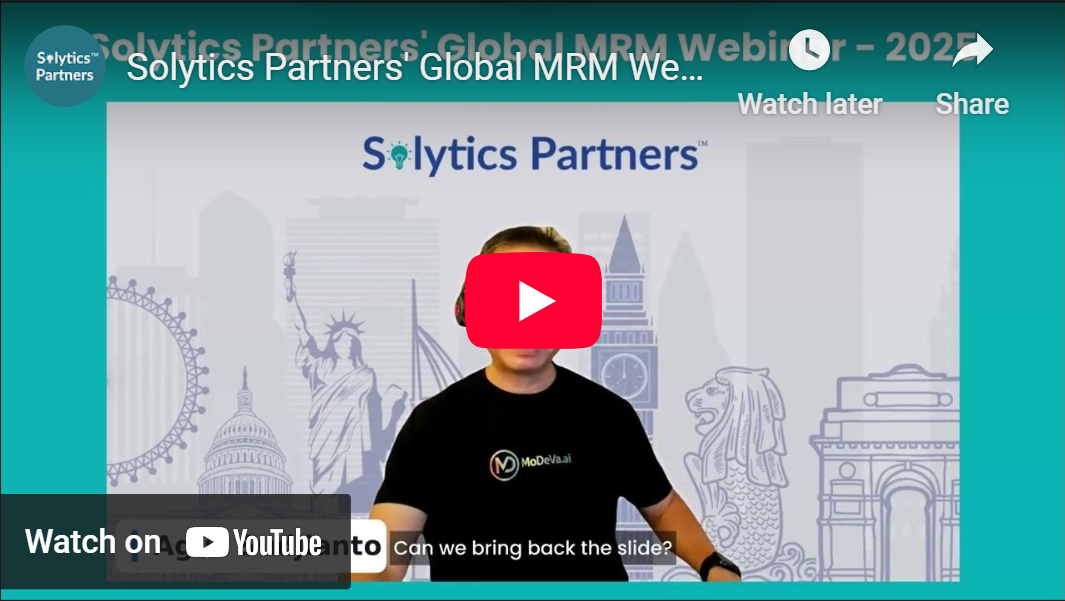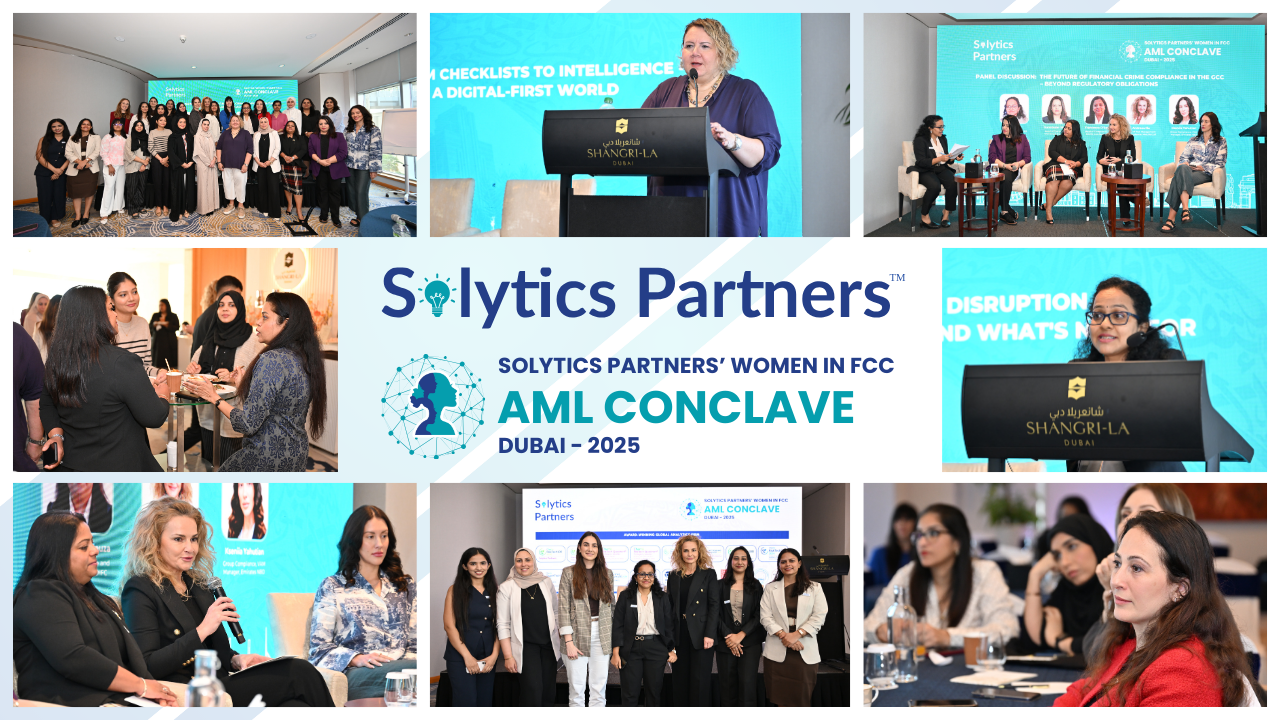Why It Matters
As financial institutions increasingly adopt Artificial Intelligence (AI) and Machine Learning (ML) methodologies, systems or technologies, the need for robust model risk management has never been more critical. The complexity of AI systems, combined with evolving regulatory expectations, requires organizations to fundamentally rethink their approach to MRM.
Background
At the Solytics Partners Global MRM Webinar 2025, industry experts gathered to address one of the most pressing challenges in financial risk management: adapting Model Risk Management (MRM) frameworks for the artificial intelligence revolution.
Understanding the Challenge
Traditional MRM governance, inventory management, validation and monitoring practices, designed for conventional statistical models, face significant limitations when applied to AI and machine learning systems. The limited control on training data, infinite promting possibilities, wide range of outputs, billions of parameters for the mdels nature of many AI models, combined with their complexity and rapid evolution, creates new validation and governance challenges that require innovative solutions.
Key Discussion Points:
- From Reactive to Proactive Risk Management
- Agus Sudjianto emphasized the critical need to "forward-looking" validation techniques when before putting the AI systems in production
- Identifying model weaknesses and failures before they occur in production environments and establishing correct governance
- Building predictive validation frameworks that anticipate risks rather than merely responding to them
- Solving the AI "Black Box" Problem
- Introduction of inherently interpretable machine learning models as a solution to opacity challenges
- Balancing model performance with transparency requirements
- Ensuring stakeholders can understand AI models and trust AI-driven decisions
- Comprehensive Testing for Generative AI
- Specialized testing methodologies required for generative AI models
- Transparent evaluation methods that address unique risks in generative systems
- Establishing ground truths and bounded problems for effective validation
- Ecosystem Approach to Model Risk Management
- Alberto Ramirez presented integrated solutions combining analytics platforms and model inventory tools
- The importance of centralized model management for transparency and regulatory compliance
- Building infrastructure that supports both traditional and AI model governance
- Multidisciplinary Team Requirements
- Essential involvement of Chief Risk Officers, Chief Data Officers, and Chief Technology Officers
- Breaking down silos between risk, data, and technology teams
- Creating collaborative frameworks for effective AI governance
- Human Calibration and Oversight
- The irreplaceable role of human judgment in AI validation processes
- Establishing clear roles and responsibilities for model owners and validators
- Building systems that support human decision-making while leveraging AI capabilities
- Regulatory Compliance and Disclosure
- Growing requirements for banks to disclose model information to central banks
- Particular emphasis on developments in Latin America and Asia
- Ensuring transparency while maintaining competitive advantages
Expert Insights:
Webinar Takeaways:
Key actionable insights, included:
- Key practices for adapting traditional MRM to AI and ML models
- Strategies for implementing transparent evaluation methods for generative AI
- Best practices for building multidisciplinary teams capable of AI governance
- Approaches to balance innovation with regulatory compliance requirements
The Path Forward
The webinar concluded with discussions on establishing comprehensive model risk management frameworks that can adapt to the rapid pace of AI innovation.
- Developing hybrid approaches that combine generative AI with traditional ML models
- Creating documentation standards that highlight key risks and mitigation strategies
- Building infrastructure that supports continuous learning and adaptation
Closing Remarks
This session emphasized that successful AI adoption in financial services requires more than just technological implementation, it demands a fundamental transformation in how organizations approach model risk management. The future belongs to institutions that can effectively balance innovation with robust governance, transparency, and regulatory compliance.
The webinar reinforced that while AI offers transformative potential, its implementation must be guided by comprehensive risk management frameworks, strong governance structures, and a deep understanding of both technological capabilities and limitations.
Webinar Materials
Click here to access the recording and Q&A summary from the session: https://drive.google.com/drive/folders/1ccW3emgVERuXJr3cwATNOaj5PDtmksSs?usp=sharing
Want to know more about us?
Please contact us to book a session with one of our experts
The Panelists
Agus Sudjianto, (Senior Advisor - Solytics Partners)
Agus Sudjianto, Senior Advisor at Solytics Partners, he has over 30 years of experience in engineering and banking and holds 25+ U.S. patents. He is the co-creator of PiML, a tool for high-risk machine learning models, which has been widely adopted across industries. After three successful years, he launched its successor, MoDeVa. Built on PiML’s foundation, MoDeVa reimagines model development and validation. It offers enhanced capabilities, improved usability, and expanded ML interpretability. MoDeVa is designed for high-stakes, regulated environments, making it the ultimate toolkit for model development and validation.
Alberto Ramirez, FCA, MAAA (Partner - Risk Analytics at Solytics Partners)
Alberto Ramirez, FCA, MAAA (Partner - Risk Analytics at Solytics Partners) is an experienced risk and analytics leader with extensive expertise in model risk management (MRM) across banking and insurance sectors. He has led MRM adoption, validation, and governance programs for major banks and insurers, integrating regulatory compliance with business value. His work spans credit risk, market risk, and insurance actuarial models, combining quantitative analysis with strategic advisory. As a Partner at Solytics Partners and Research Leader at the Society of Actuaries, he has published reports on enterprise risk management and insurance innovation, demonstrating strong cross-functional leadership and technical acumen in complex model risk environments.



.png)


.svg)


